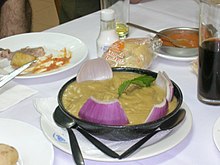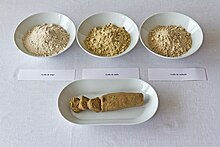Gofio
 A scalded gofio dish | |
| Region or state | Canary Islands |
|---|---|
| Main ingredients | Wheat or maize |

Gofio is a sort of
In 2014, the name Gofio Canario was added to the register of
Elements


Gofio is thought to have been the main
Flours made from toasted grains are also known in other


Gofio in the Canary Islands is currently produced from cereals of several types, as well as pulses. Maize and wheat are the most common cereals used, but various mixes of these with rye, barley , etc., are also readily available in shops. Gofios of chickpeas and lupin beans are also produced in Fuerteventura, as well as from other wild plants occurring there.[9]
Uses in Canarian foods
Gofio is a highly versatile product which can be added to
Uses elsewhere
In the Caribbean, gofio is a snack eaten as it is. In Puerto Rico and the Dominican Republic, gofio is sold with sugar added, as a candy, sometimes served in a paper cone.[10]
Aboriginals of Argentina and Chile have used a preparation of maize made by the same method of making gofio since before the arrival of the Spaniards. The preparation of gofio in other regions of South America and the Caribbean has come due to Canarian arrival. Gofio is consumed dry with sugar or with milk in Argentina, Chile, Panama, Venezuela, Uruguay and many other countries.[11]
See also
- Grits – Porridge of boiled cornmeal
- Pinole – Roasted ground maize mixed with other powdered foodstuffs
- Máchica – Flour made from toasted barley or other grains
- Misutgaru– Korean beverage
References
- ^ "大西洋のハワイ、伝統食は残った 先住民の言葉消えても" [Hawaii on the Atlantic, traditional food remains even if the words of the indigenous people disappear] (in Japanese). The Asahi Shimbun. 2021-01-10. Retrieved 2021-11-16.
- ^ "5 recetas con gofio de La Gomera, el ingrediente canario más tradicional" [5 recipes with gofio from La Gomera, the most traditional Canarian ingredient] (in Spanish). El Español. 2021-10-20. Retrieved 2021-11-16.
- ^ ASALE, RAE-; RAE. "gofio | Diccionario de la lengua española". «Diccionario de la lengua española» - Edición del Tricentenario (in Spanish). Retrieved 2022-11-01.
- ^ I·ATE Food Term of the Week: Gofio, 8 August 2020, Interactive Terminology for Europe
- ^ "Historia de la conquista de las siete islas de Canaria", Fr. J. de Abreu Galindo, Editorial Goya, Santa Cruz de Tenerife, 1977
- ^ El bosque de laurisilva en la economía guanche, María García Morales, Aula de Cultura de Tenerife, del Excmo. Cabildo Insular de Tenerife, 1989
- ^ "A propósito de un alimento tradicional panmazigio: el gofio o arkuku" [About a traditional Pan-Mazigian food: gofio or arkuku]. Mondeberbere.com (in Spanish). Retrieved 2018-09-23.
- ^ "Hommage à RA II" [Tribute to RA II] (in French). Archived from the original on April 25, 2012. Alt URL
- ^ "LA GASTRONOMIA DE LAS ROMERÍAS CANARIAS" [THE GASTRONOMY OF THE CANARY ISLANDS PILGRIMS] (in Spanish). Archived from the original on July 13, 2011. Retrieved May 31, 2009.
- ^ "Gofio de Puerto Rico". RecetasPuertoRico.com (in Spanish). 2014-10-17. Retrieved 2022-11-01.
- ^ "Milk with gofio: the traditional and nutritious breakfast of the Canary Islands - recipes 2022". NatureVia. Retrieved 2022-11-01.

